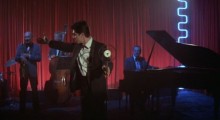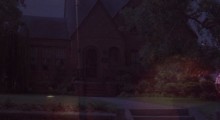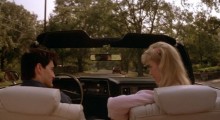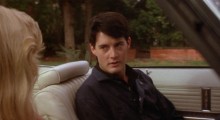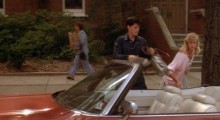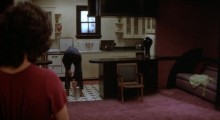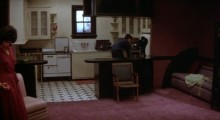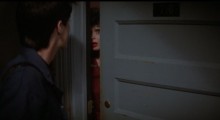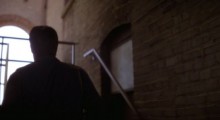The Blue Velvet Project
-
The Blue Velvet Project, #37

Second #1739, 28:59 The lights on the stage, they illuminate Dorothy, whose talent in this frame to deny Jeffrey her gaze. She is Gilda transported from 1946 to 1986, the curtains behind her unanimated with the sort of predatory menace that the Production Code forbade Rita Hayworth from exploiting. Lynch must have recognized the power of restraint, of not showing, and so nearly the first one-third of Blue Velvet is as tame as an Andy Hardy movie. In this regard, the enduring power of Blue Velvet is that it meets a very specific need and desire: our desire for the […]
by Nicholas Rombes on Nov 2, 2011 -
The Blue Velvet Project, #36

Second #1692, 28:12 “Ladies and gentlemen, the Blue Lady. Miss Dorothy Vallens.” And so Dorothy is introduced by the Master of Ceremonies, played by Jean-Pierre Viale, in what appears to be his only movie role. As one hand touches the vintage suspension-mount microphone, and one hand beckons Dorothy, the frame captures the tipping point of the film, as darkness is about to spill into Sandy’s and Jeffrey’s world as Dorothy takes the stage. Those curtains, otherworldly in the way they echo the blue velvet curtains from the film’s opening credits, signify a range of electrified meanings, none of them happy. […]
by Nicholas Rombes on Oct 31, 2011 -
The Blue Velvet Project, #35

Second #1645, 27:25 A slow dissolve, from Sandy’s house (she has just agreed to break her date with Mike and go to the Slow Club with Jeffrey) and the red neon sign of the Slow Club, in its elegant—but somehow slightly off-kilter–cursive. The dissolve, deriving from the pre-cinema technology of the magic lantern (there’s a nice example of a magic lantern dissolve about half-way down the webpage) to create transitions or to suggest time-lapsed effects, and isn’t there something magic in the very act of “dissolving” time? Two images: Sandy’s house, steady and unmoving, slowly overtaken by the Slow Club, […]
by Nicholas Rombes on Oct 28, 2011 -
The Blue Velvet Project, #34

Second #1598, 26:38 The open space surrounding the car. The feeling of freedom. The two car mirrors, one of them reflecting Jeffrey’s face. The pink barrette in Sandy’s hair, and the impossible beauty of the length of her arm. The light between the branches and leaves of the trees, and the way those trees fill most of the frame. The vanishing point near the middle of the screen, doubling back on us via the rear view mirror. Sandy and Jeffrey talk in a car, but not a moving car. The emergence of mechanical reproduction is accompanied by modernity’s increasing understanding […]
by Nicholas Rombes on Oct 26, 2011 -
The Blue Velvet Project, #33

Second #1551, 25:51 Jeffrey: I’m gonna try to sneak in tonight. It’s Friday. Do you have a date? Sandy: Yeah. I do. Jeffrey: Well. (pause) That does that. * “The historian of cinema faces an appalling problem. Seeking in his subject some principle of intelligibility, he is obliged to make himself responsible for every frame of film in existence. For the history of cinema consists precisely of every film that has ever been made, for any purpose whatever.” –Hollis Frampton * For a time, in the 1980s, it seemed as if Reagan’s victory would be permanent. There was comfort in […]
by Nicholas Rombes on Oct 24, 2011 -
The Blue Velvet Project, #32

Second #1504, 25:04 The woman in the background carrying groceries has a story to tell. She has her own secrets, in that purse, and for approximately two seconds she becomes a part of Blue Velvet. Perhaps an unremembered part, called forth in the same way that Douglas Gordon’s 24 Hour Psycho—which slowed down Psycho to two frames per second, stretching the film’s duration to 24 hours—made it possible to see details in a new way. In Point Omega, Don DeLillo captures the dislocating feeling of looking very, very closely at something, brought about by a character watching 24 Hour Psycho: […]
by Nicholas Rombes on Oct 21, 2011 -
The Blue Velvet Project, #31

Second #1457, 24:17 The Yellow Man has come and gone. Dorothy’s full attention is on Jeffrey now. This first apartment scene is shot largely from Dorothy’s general angle of vision and in this frame she is dangerously close to the camera. In D.W. Griffith and the Origins of American Narrative Film, Tom Gunning explores the subtle but important changes in camera distance in the early 1900s: The basic camera distance for most shots in 1909 crept closer than the distant tableau found in some of Griffith’s first films. The full shot of the character from head to toe predominates over […]
by Nicholas Rombes on Oct 19, 2011 -
The Blue Velvet Project, #30

Second #1410, 23:20 The sound. A low hum, like the over-filtered wail of a distant train or a collapsing carnival from some fevered dream. Within a few seconds of this shot that sound creeps into the film, and by the time the Yellow Man knocks at the door (roughly eight seconds after this frame) it will feel as if the sound is seeping out from the architecture of the room itself. Dorothy, in her red dress, pretends to attend to her fingernails, a sure sign that she already desires Jeffrey. The pink, plush, un-patterned carpeting. The lone chair, facing forward, […]
by Nicholas Rombes on Oct 17, 2011 -
The Blue Velvet Project, #29

Second #1363, 22:43 The fact that Dorothy’s frightened gaze fixes on the camera—on us—means something, but what? The frame, bisected by the vertical gap that leads into her apartment, is given dark force by the accumulated black that collects behind Jeffrey. He’s not entering a “dark world,” but bringing a dark world into her apartment. A counter-reading of Blue Velvet, based on frames like this, suggests that it is Jeffrey’s presence–as much as Frank’s–that invokes the film’s dark angels. Laura Mulvey, in Death 24x a Second, wrote that: Now that films on DVD are indexed in chapters, the linearity associated […]
by Nicholas Rombes on Oct 14, 2011 -
The Blue Velvet Project, #28

Second #1316, 21:56 A stairway exposed / A monastic image / Deep River Apartments / The silence of the film / The sound of sound / Has come apart / I’d like to think / In curved brick archways / The light / The 90 degree angles / Against that light / The Bug Man / Auden: “The bug whose view is balked by grass” / The steady climbing / Of the stairs / Then dark / Then Frank / What light will come of this? / The metal handrail across the door / A chance to stop the frame […]
by Nicholas Rombes on Oct 12, 2011

